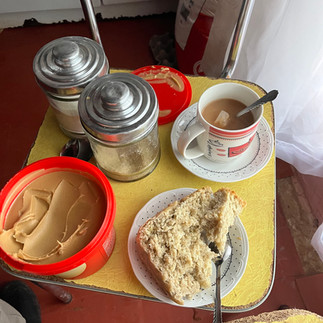Lesotho - Foodie addition
- Kamrin Hooks
- Oct 1
- 3 min read
Updated: Oct 10

As part of our Pre-Service Training (PST) curriculum, we’ve been learning how to prepare traditional Basotho meals and getting used to the local food. It’s an interesting shift from the American diet I’m used to, but in some ways it feels familiar, especially coming from the South!
Culturally, meals remind me of being at Granny’s house; my plate is never full enough for them, and sometimes they watch me eat while smiling. So cute and funny and awkward!
I’ve started asking to make my own plates, but even then, the side-eye I get for my small portions is vicious. It’s a gesture of love and care, but for someone who routinely skipped breakfast and sometimes dinner back in the States, it’s been an adjustment. If I’m not careful, I’ll be stretching my shirts out soon.
Let’s talk about the food itself!!!
Papa is a staple here: dried corn ground down to grains and cooked in boiling water. It reminds me of grits. I made the mistake of adding sugar to it once and had a good laugh with my host family over that social norm fail! Cringe.
Papa is often served with moroho, a mix of cabbage, spinach, and/or onions. It’s actually quite good, and with a bit of Cajun seasoning from home, it’s an easy 10/10!
For protein, I’ve mostly had chicken. At the hotel I mentioned in an earlier post, we had BBQ, but in the village it’s more common to have chicken boiled with sauce. Lamb, goat, and sometimes pork are also available.
Because there’s no electricity in my village, refrigeration isn’t an option. That means no butter, and cooking oil, though widely used, is pricey, so deep-frying isn’t common. KFC is ironically available here, and I plan on stopping by soon for a bit of comfort food from home!
Some sides I’ve come across but didn’t manage to photograph include beets.
Butternut squash, Green peas, and rice have also made a few appearances!
Being a landlocked kingdom, Lesotho doesn’t have much of a seafood market. I’ve shown people pictures of me eating crawfish, and the general reaction has been one of disgust, accompanied by lots of gagging and head shaking. They do look like bugs, so I suppose the name “mud bugs” is fitting, haha. It’s funny how something normal to one culture can be strange to another, and vice versa.
The most familiar foods I’ve had here in terms of taste have been peanut butter sandwiches on homemade bread, eggs and toast, and rice with peas. At home, I’d probably pass them over for other options, but here they’re comfort foods that make me smile. It’s funny the things we take for granted. 🤷🏽♀️
Now let’s talk spices!!!
I have a theory: the farther a country is from the equator, the less spicy or seasoned its food tends to be. Someone fact-check me, but I think I might be on to something!
Currently, salt is the only seasoning I’ve used. I want to experience Lesotho food in its proper form, but the sauces and spices I tucked into my luggage are waiting for their debut. Soon, I’ll be introducing my host family to Louisiana flavors—Tony’s seasoning and hot sauce included! My prediction? Lots of giggles and coughing, and hopefully no gags hahahahahaha.
POST EDIT: My family has told me that the Peace Corps informed them that Americans are not fans of salt or spice!!! WHAT! so please accept this correction. After a great talk with my host family I now see seasoning and sauces. The food is great! I am still going to introduce them to my Cajun seasoning!
Any suggestions on what Southern dishes I should make for them, keeping in mind we don’t have electricity?
Tsamaea hantle!!!
-Kene Moshe
Food is out common ground, a universal experience. - James Beard









Cornbread, catfish, hush puppies, and fried chicken please
I am glad you are finding some familiar items. It’s crazy when I see this plate I have eaten this plate. You could switch the butternut squash for sweet potatoes and it’s home! I can’t wait to see how they feel about the Tony’s…❤️